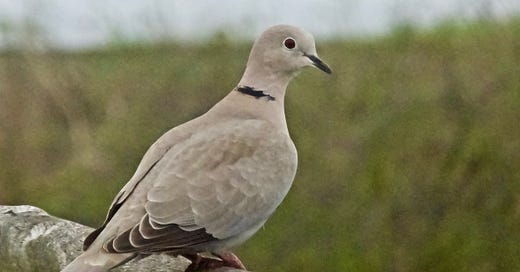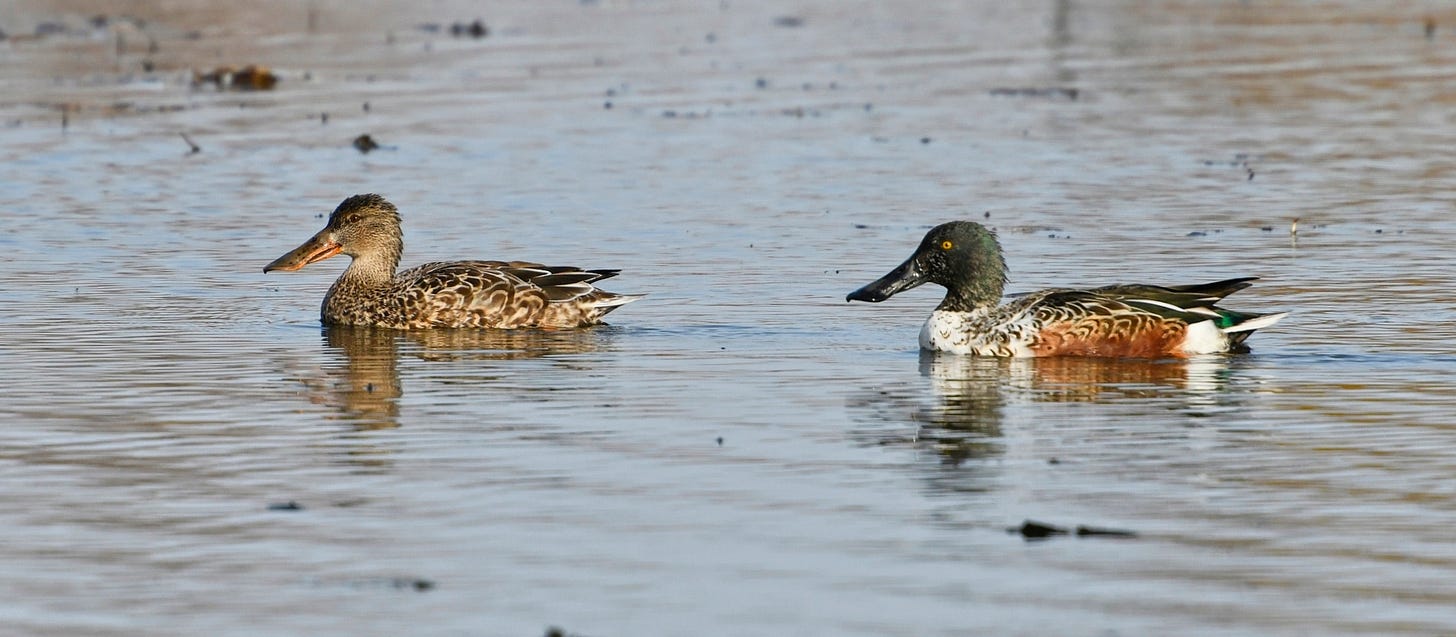Wossname
I saw some birds this week. Nice, they were.
There was that tiny olive-coloured flitty one with the flame-stripe on its head and the extraordinarily high-pitched call, dodging between the leaves and then out of sight, leaving behind it merely the quivering aura of its movement.
There was that streaky brown wotsit, shouting at me from the top of a bush.
There were those blue-and-yellow doodahs hanging upside down from the feeders, all action and movement and flurry and cheep-cheep and gone and oh yes now they’re back and nope gone again.
There was that piebald dude with the bouncing flight and a crazed look in its eye, banging its head against the bark.
Then on the pond there were those obnoxious shouty arseholes, about forty of them, splashing around and divebombing each other and making a hideous racket with as much consideration for their fellow pond-users as a Friday night stag party in Clapham. Dapper-looking birds, sure, but ruffians and hooligans, despite that butter-wouldn’t-melt white plumage.
And then there was that russet-coloured skulker with the short, hooked beak, eyeing me with quiet menace from its habitual perch, its immobility that of a bird that knows it could take me down in a second if it had to.
And if you got from all the above that I saw a firecrest, a song thrush, some blue tits, a great spotted woodpecker, a bunch of black-headed gulls and a kestrel, then congratulations.
Describing things is fun, but names have their uses.
Collared Dove
Never watch television with a birding pedant. They’ll make your life hell. You might be enjoying that period drama, scenes of romance, intrigue and scheming playing out against a backdrop of stately homes and vistas of rolling parkland, but the birding pedant has other concerns.
“Well that’s not right. The collared dove only started breeding in this country in 1956.”
Historically accurate perhaps, but come on, there’s a time and a place.
The collared dove’s spread through Europe is unmatched by any other bird. Originally based in Asia, and its European range restricted to the south-east until the early 20th century, it’s now familiar everywhere on the continent except the furthest north-eastern reaches, its three-syllable hoo-HOOOO-hoo call resounding across suburbs and farmland from Oslo to the Algarve. While the trigger for this rapid sweep isn’t known, their fondness for seeds and grains, along with their ability to raise multiple broods in a year, will no doubt have eased the path.
Some might call the collared dove’s plumage bland or nondescript. Others might consult the Farrow & Ball colour chart and come up with Pointing, Wevet, Dimity or Slipper Satin. Still others might recall the various shades of the great Richie Benaud’s jackets, and opt for cream, bone, off-white, ivory or beige.
Whichever vocab you choose, the gentleness of the plumage is reflected in the call, that soft cooing typical of the Columbidae, the family consisting of pigeons and doves. Simon Barnes, equal in his enthusiastic observation of both birds and sport, likens it to the bored football fan chanting “U–ni–ted, U–ni–ted”.
The distinction between ‘pigeon’ and ‘dove’ is one that exercises Facebook birding groups from time to time. The terms are often used interchangeably, and the differences anpparently arbitrary. A common theme is that birds whose names contain the word ‘dove’ (about 190 of the 350-odd species in the family, versus about 160 containing the word ‘pigeon’) are generally – generally, mind, there are always exceptions – smaller. ‘Dove’ has Germanic origins, ‘pigeon’ French. ‘Dove’ has connotations of peace, ‘pigeon’ (incorrectly in my view) of dirtiness and unwelcome urban ubiquity. Dove is a brand of personal care products, as well as the American name for the chocolate bar known in Britain as ‘Galaxy’; ‘Pigeon is a South Korean manufacturer of household products. Take your pick.
The family contains – or contained, to be strictly accurate – two poster birds for the ravages wrought on birds by humans: the dodo and the passenger pigeon, about both of which much has been written (a lot of it, in the dodo’s case, highly debatable). Spare a thought, then for the Rodrigues solitaire. Cousin to the dodo, it was also a ground-dwelling bird restricted to a single island, and also hunted and predated to oblivion in the 18th century. Its relative anonymity might simply be a function of its less immediately memorable name. All three species – and many others –are a salutary reminder that abundance is never permanent – bear that in mind the next time you see a collared dove and drink in its soft – bone, ivory, beige, whatever – plumage.
Shoveler
If it looks like a duck, swims like a duck, and quacks like a duck, then it probably is a duck.
And if it has a massive hooter, then it’s a shoveler.
Interesting bird, the shoveler (or northern shoveler, to give its full name). The male has that dark head, not dissimilar to the mallard; and its body has a variegated colour scheme recalling the shelduck’s. As for the female, like so many ducks of that gender it’s often dismissed as nondescript, but get up close and give that streaky brown plumage a good looking-at and there’s much to admire.
But whatever the attractions or otherwise of the plumage, it’s all too easy to fixate on that bill, simply because it’s the one defining feature setting it apart from all other British ducks. “Diagnostic”, as the field guides like to have it.
The bill’s utility (as distinct from “utility bills”, which are something else altogether) is reflected in the bird’s name, and this is a pattern repeated in several other languages, from Löffelente (“spoon duck”) in German to mestolone (“big ladle”, which seems to be laying it on rather thick, quite frankly) in Italian. The shoveler, of course, has the last laugh, because that “extraordinary appendage” (Birds Britannica) is perfectly adapted for its feeding style, sifting through the water in search of little crustaceans just below the surface. The shoveler belongs to the group known as ‘dabbling ducks’ – not for them the underwater acrobatics of the diving ducks (pochard, scaup and tufted duck, to name but three). They prefer to float serenely on the surface, scooping up whatever foodstuffs come within their purview – in the case of the shoveler, these are tiny crustaceans, snails and other aquatic invertebrates, which they strain through the tiny serrations on that “huge, spatulate”(Peterson) bill. If pushed, they might stretch to a bit of upending, their shapely behinds waggling in the air as they rotate on their central axis to allow their head to get a bit deeper. Sometimes, if their prey is proving recalcitrant, they’ll whizz round in tight little circles, creating a whirlpool to bring the food to the hunter rather than vice versa. A group of shoveler engaging in this activity as a group is a sight to be relished.
Ruff
This is pretty extraordinary. It would be easy to assume that birds are sedentary during breeding season, and that if they’re unsuccessful in getting paired up they simply shrug their shoulders, stay alive, and wait till the next year. But some, it turns out, will go to great lengths and distances to find a partner. Up to 9,000 km, in some cases.
Photos
For lovers of avian prettiness, there are some fantastic photographs in this ‘best of the last year’ collection from the Macaulay library.






I do love
a collared dove
hoo-HOO-hooing
from above
The first section here is very amusing. My father used to always call swans 'whte doodahs' specifically to annoy me i think.
Collared Doves often nest somewhere near our flat and are always lovely neighbourghs, I particularly like watching their display flights.
I occasionally see Shovelers and female Ruffs, but have never yet seen a male Ruff (well not in breeding plumage anyway).
The photos at the link are beautiful.